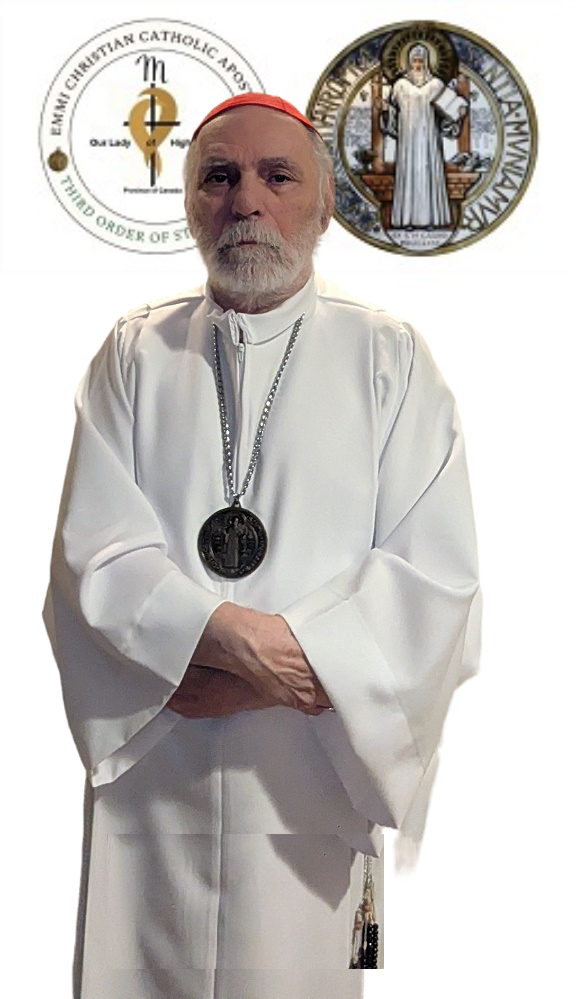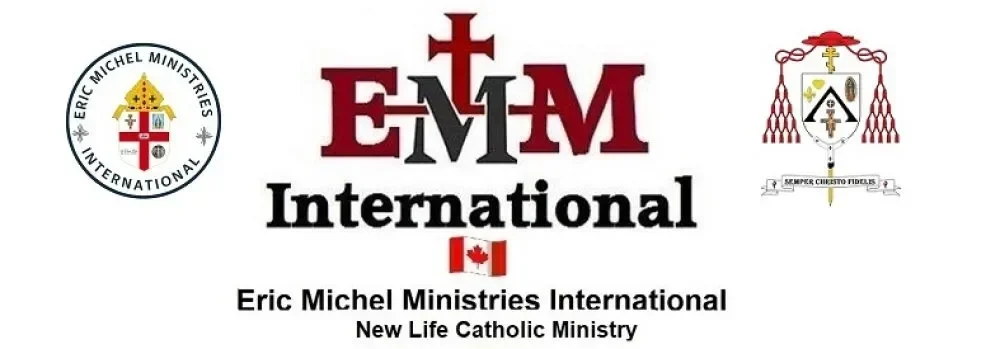
The Eric Michel Ministries International in Africa, the Benedictines of Our Lady of High Grace is a Third Order of priests and brothers and sisters an lay people, founded in 2023, by The Most Reverend Brother Eric M. Gagnon, Metrop[olitan Archbishop. Our white habit is based on the traditional North African dress of a white gown (gandoura) and a white hooded cloak (burnous). A rosary is worn at the belt cienture to show we are people of prayer. Please note that the EMMI North American Third Order of Benedictines of Our Lady of High Grace the habit is gray. For the members of of the White Robe Monk of Saint Benedict that wear white tunic they are not member of a Third Order.
About
A Benedictine Third Order that is lay individuals or families associated with the Benedictine of Eric Michel Ministries International, sharing in its spiritual life and practices without taking public vows, we strive for holiness in our daily lives by following the wisdom of St. Benedict’s Rule, living in the world but committed to the New Life Catholic Ministry community through a lifetime commitment.

What is a “Lay Benedictines?”
Lay Benedictines (also known as “Third Order Benedictines”) are Christians who belong to a Lay Fraternity connected to the religious order founded by St. Benedict.” Lay Benedictines Order direct their lives around our four pillars: Prayer, Study, Community, and Preaching.
What is a “Fraternity”?
A fraternity is a stable community formally affiliated with certain groups. In the case of Lay Benedictines, a Lay Fraternity is affiliated with the EMMI Benedictines of Our Lady of High Grace. This means that the fraternity is under the leadership and authority of different representatives of the Order.
What is an “Order”
During the history of Christianity, groups of men and women have often created communities to serve the God and His Church. Early monastic communities are examples of this, where individuals joined together to offer prayer, asceticism, and study under a common rule and way of life. Their rule and mission “ordered” their lives. In the West, the Benedictine Order of monks and nuns are an example of this. Later, during the middle ages, as the needs of the Church evolved, new orders were founded to address specific challenges. St. Francis, for example, founded the “Order of Friars Minor” in 1209 specifically to serve the poor in urban environments. St. Dominic, founded the “Order of Preachers” in 1216 to preach against heresy and teach the faith. Benedict of Nursia (Latin: Benedictus Nursiae; Italian: Benedetto da Norcia; 2 March 480 – 21 March 547), often known as Saint Benedict, was a Christian monk. He is famed in the Catholic Church, the Eastern Orthodox Church, the Lutheran Churches, the Anglican Communion, and Old Catholic Churches. In 1964, Pope Paul VI declared Benedict a patron saint of Europe.
Benedict founded twelve communities for monks at Subiaco in present-day Lazio, Italy (about 65 kilometres (40 mi) to the east of Rome), before moving southeast to Monte Cassino in the mountains of central Italy. The present-day Order of Saint Benedict emerged later and, moreover, is not an “order” as the term is commonly understood, but a confederation of autonomous congregations.
Benedict’s main achievement, his Rule of Saint Benedict, contains a set of rules for his monks to follow. Heavily influenced by the writings of John Cassian (c. 360 – c.435), it shows strong affinity with the earlier Rule of the Master, but it also has a unique spirit of balance, moderation and reasonableness, which persuaded most Christian religious communities founded throughout the Middle Ages to adopt it. As a result, Benedict’s Rule became one of the most influential religious rules in Western Christendom. For this reason, Giuseppe Carletti regarded Benedict as the founder of Western Christian monasticism.
Each order is unique in its rule and its charism (its purpose). For example, the Order is unique in that following our rule is obligatory, but we are not bound to it under pain of sin, the way that members of other orders are. So, for example, we are obligated to pray the Rosary every day, but not under pain of sin if we don’t. Similarly, while there are many fine preachers in other orders, only the Benedictines devote their entire order to this purpose.
What is a “Third Order”?
Religious orders are generally made of of monks, friars, and nuns who live in community and make vows of poverty, celibacy, and obedience. However, many orders also have branches for those who are attracted to the charism of the order, but are unable to live in community or take these vows.
For example, St. Rose of Lima was not able to join a convent as a nun because she needed to help take care of her family, and so she joined the Third Order of St. Dominic, which allowed her to live at home but still take part in the mission of the order. Another example would be St. Louis de Montfort, who was a parish priest, but later became a Third Order Dominican to help in the Order’s promotion of the Rosary. Obviously, married persons are not able to take a vow of celibacy, and so many married people who are attracted to the charism’s of different orders join their third order branches.
Secular Franciscans, Lay Dominicans, and Benedictine are examples of third orders.
How does the EMMI Order fit in the Church?
The EMMI Order is primarily dedicated to preaching. Because of this, many Benedictines work in parishes, give retreats, write books or articles, or teach. For this reason, assiduous study of sacred scripture, the Church Fathers, and other religious works is a hallmark of our Formation .Benedictines also are responsible for the promotion of the EMMI Confraternity of the Most Holy Rosary, which promotes Holy Mary and the Rosary. Every Benedictines directs and orders his life towards the successful preach.
How do Lay Benedictines fit within the Order of EMMI?
- Apostolic Sisters
- Lay Benedictines, who run various apostolates and work in their private lives to preach the Gospel.
- Priestly Fraternity of St. Benedict.
How do Lay Benedictines fit within the Ministry?
Lay Benedictines are faithful Christians in full communion with the Apostolic Old Catholic Mission. We serve God and the Church through our support of orthodox preaching, teaching, and catechesis. Lay Benedictines participate in the liturgical life of the Church through frequent reception of the sacraments like confession and the Eucharist and in our praying of the Divine Office (“Liturgy of the Hours”) daily. https://franciscanseucharist.ca/reading-of-the-day/ French https://franciscanseucharist.ca/lecture/
Lay Benedictines work in other ministries and apostolates serving the poor, volunteering at their parish, and, in general, sanctifying the secular world.
What are the obligations for a Lay Benedictines?
A Lay Benedictine commits to the following (though not under pain of sin):
- Following our rule
- Daily recitation of the Rosary
- Daily recitation of Lauds and Vespers (Morning and Evening Prayer) of the Divine Office (Liturgy of the Hours) https://franciscanseucharist.ca/reading-of-the-day
- Attending and participating at Fraternity meetings, including the study of any formation materials or other materials as assigned
- Attending a yearly retreat
- Directing and Ordering one’s life towards our pillars of prayer, study, community, and preaching
What is the process for becoming a Lay Benedictine?
Postulancy (“Inquiry”). A postulant attends meetings and investigates the basics of the order to help discern if God is inviting them to join this fraternity. This process lasts at least six months. Afterwards, the postulant can ask to formally join the Benedictines as a novice. Postulants have no other obligations other than to be listening for God’s voice, although they are encouraged to start doing things like daily recitation of the Rosary and Divine Office..
Novitiate. A Novitiate receives a scapular as a sign of their affiliation with the order and begins to live a New Life, including praying the Divine Office, reciting the Rosary daily, and entering more formally into formation. In many ways, a novitiate’s internal response to these three voluntary commitments are key to their discernment process. Someone who finds a commitment to saying Lauds and Vespers Daily irksome instead of spiritually fulfilling, or is unable to set aside time for formation materials may have a good indication of whether this way of life is a good fit for them. On the other hand, for many Lay Benedictines, these commitments fill a hole in our hearts we didn’t know was there.
Temporary Promises. At the end of the Novitiate (usually at least a year), the Novice can ask to make temporary promises for a three-year period. In many ways the difference is that what had been voluntary during the novitiate is now obligatory, and formation materials are more rigorous. At this point, someone is a full member of the Benedictine Order, with all obligations and benefits. Before temporary promises are allowed, existing members of the fraternity will vote on whether or not to accept you into their community.
Final Promises. At the end of this three year period, the temporarily professed member will either make final (permanent) promises, renew (but only once) their temporary promises, or leave the Order.
The Rule
There isn’t a separate “Third Order Rule” of Saint Benedict; instead, Benedictine Oblates (lay members of the Third Order) commit to living out the same Rule of St. Benedict as monks and nuns, but adapted to their own secular lives and circumstances. This involves making a spiritual “oblation” to live according to the values of the Rule, such as humility, obedience, and prayer, within their families and communities.
Key Aspects of the Benedictine Rule for Oblates
Adaptation, Not a Separate Rule:
The Rule of Saint Benedict was not written specifically for the laity, but its wisdom has been applied to guide both religious and secular people for over 1500 years.
– Oblation of Self:
Oblates make an oblation, which is a spiritual “offering of self,” to live out the values of the Rule.
– Focus on Benedictine Values:
The Rule emphasizes core principles like:
- Humility: Developing a deep sense of humility and self-effacement, as outlined in the twelve steps of humility (Chapter 7).
- Obedience: Submitting one’s will to God’s will and obeying superiors, even when their actions might seem contrary to the Rule.
- Prayer: Engaging in regular prayer, both communal and personal, recognizing God’s omnipresence.
- Work: Performing manual work and other tasks for the glory of God and the good of the community.
- Balance: Seeking a balanced life of prayer, work, and leisure, and following a “middle way” rather than excessive austerities.
- Community and Service: Fostering mutual love and respect within the community, and serving guests and one another.
Spiritual Affiliation:
- Oblates are affiliated with a specific Benedictine monastery where they make their oblation.
- How it Differs from the Monastic Rule
No Vows or Community Living:
- Unlike cloistered monastics, oblates do not take religious vows or live in a monastic community.
Secular Circumstances:
- They apply the Rule’s principles to their daily lives within their families, jobs, and social settings.
